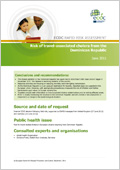# 6185
Today the ECDC released a Risk Assessment on the H5N1 transmissibility studies conducted by Fouchier and Kawaoka that illustrates the difficulty that all of us are having in assessing this story.
Outside of a closed circle of scientists, none of us have access to all the facts.
And apparently, some of the details that have been reported – according to Ron Fouchier at this morning’s ASM Biodefense webcast – have not been completely accurate.
All of which makes it very difficult to sit back and make any sort of informed judgment from the sidelines. The ECDC’s executive summary acknowledges these limitations by stating:
This document’s starting point is that without sight of data and analyses it is very difficult to undertake risk assessments. It is not even clear at present how pathogenic these viruses are in animal models. The
document also puts forward the ECDC position on some of these issues according to ECDC’s limited mandate, recognising the value of the research but also the potential risks.
ECDC stresses the need to consider mechanisms
for a robust biorisk-management approach along the lines of international standards and EU-wide guidance on laboratory biosafety/biosecurity for any future emerging threats.
ECDC indicates that it would advocate open publication of the findings and emphasises the importance of sustaining and enacting the pandemic influenza preparedness framework with its underpinning global virological surveillance and sharing of information and benefits in order to enhance global health security.
It is ECDC’s intention to support the European Commission and Member States, to monitor these developments closely and with its stakeholders and collaborators to revisit its risk assessment for A(H5N1) viruses as the research findings emerge.
Nonetheless, this ECDC risk assessment does a good job in defining many of the complex issues at hand, even if definitive answers are elusive.
Risk assessment: Laboratory-created A(H5N1) viruses transmissible between ferrets
Technical reports - 29 Feb 2012
Available as PDF
ABSTRACT
The results of two, as yet unpublished, investigations of laboratory-induced genetic changes in avian influenza A(H5N1) viruses have been reported to have found that a surprisingly few number of changes make the viruses transmissible between ferrets, the most commonly used model for the way influenza behaves in humans. The possibility that this could have resulted in the development in laboratories of A(H5N1) influenza viruses transmissible between humans has caused concern for public safety and generated unusually high levels of debate in the scientific community.
This report summarises and explains the complex public health and scientific issues around these developments including the positive and negative aspects of some of the responses that have been proposed internationally.
Related Post:
Widget by [ Iptek-4u ]
